
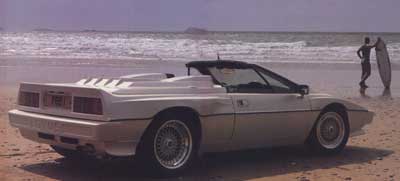
Lotus Position Reverse
Not just a chopped Lotus, but a fully developed, well engineered conversion
for owners of Esprits old and now.
And that's only the starting point
for Britain's brightest automotive engineering company, PBB Designs.
by David Summer Smith
World Sportscars, August 1989
Something was going wrong. Thousands of people had gathered at the Castle Combe Race Circuit in Wiltshire. They had travelled to the World Sportscars Supercar Test Day in late April to see exotic machinery in action. And yet the car attracting the biggest crowds was a ten year old Lotus Esprit. Not even an Esprit Turbo at that!
The logic behind this strange turn of events was not as you might expect. It was certainly not a dire shortage of exotica, indeed, the track was almost awash with supercars ranging from Ferraris and Porsches to less familiar marques the like of Lynx and Lister-Jaguars. And neither had the crowd gathered to see the gory after effects of an enthusiast's unplanned offroading.
No, the ever changing swarm had, in fact, gathered around the 1979 Esprit to study amendments that had been made to the vehicle's bodywork, changes both planned and executed by a skilled specialist. For the attention-grabbing Series 2 was simply a market research exercise. An exercise intended to answer a simple question: 'Would there be a market for Lotus Esprits in soft-top form?'
''I first had the idea for an Esprit Convertible in 1985,'' explained creator Paul Bailey. ''I had taken the concept through from preliminary drawings to a more complete pattern and wanted to bring it through to reality on a black Esprit that belonged to a friend. But he wasn't very interested at the time, so I had to buy the car from him.''
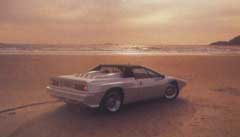
''It's probably just as well,' Paul laughs, ''because I became so busy with other work that I didn't finish the project until the Spring of 1989!''
The 'distraction' of these labours was most certainly unfortunate in delaying completion of the Convertible until after the launch of the 'new generation' Esprit in 1987, but the time was hardly wasted, for throughtout the four year period Paul was adding still further to his already substantial experience of modifying high quality cars.
A resident of Pilning, near Bristol, Paul Bailey was amongst the earliest employees of Glenfrome Engineering some fifteen years ago. An aircraft engineer by training, he had joined the Bristol-based company to carry out much of the technical work necessary in Glenfrome's custom modifications.
As well as adding rear doors to Range Rovers – long before the Swiss specialist Monteverdi supposedly prompted Land Rover to re-evaluate its feasibility – Glenfrome established an enviable position in the specialist marketplace, for they were entrusted by scores of rich, famous and stately customers to modify vehicles to their special requirements. Six-door and convertible Range Rovers were commonplace, extended wheelbase Rolls Royce Iimousines a speciality. So long as you had a bank account that could stand it, the sky was the limit – or so it seemed.
''We made some very challenging modifications to some very exciting cars,'' Paul recalls. ''There were moments when we had to question the excesses of our customer's taste – like the pearlescent orange Range Rover with six handlamps, a Rolls Royce lookalike grille and a green and maroon two-tone velour interior! But Glenfrome nonetheless grew to 100 staff at its peak, and won the Queen's Award for Exports.''
It was this dependence on export markets – most particularly the Middle East – that was to lead to the company's downfall. But not before the keen technician had added design skills to the technical expertise accumulated over an endless series of challenging new projects.
After Glenfrome's collapse, Paul was rapidly employed by newly-formed West-country firm which carries out similar work for a smaller, but even more elite, customer base. But this time it was to be in a free-lance capacity, for Paul wanted to tie his fortunes to the person in whom he had the most faith – himself. PBB Design was born.
Some of the design work undertaken – for example, the soft-top Cosworth RS500 – has yet to proceed beyond the drawing board stage. Other projects – such as a spectacular two-door Bentley Turbo R coupe – have been accepted by clients only in part. But many – the like of the 7-series BMW two-door – have been built to the highest standards and the fullest customer satisfaction.
'It was this success which brought in so much extra work and forced me to put the Esprit project on the back burner,'' Paul explains. 'The fact is; no matter how much people might like the designs produced by those talented young stylists at the RCA, they need something they can depend on before they're goint to part with any cash. Experience counts for an awful lot...'
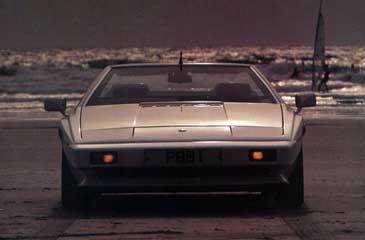
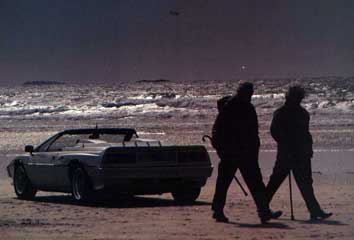
'It was that experience that allowed me to take on the Esprit project with such confidence,' the designer continues, 'I could take it from the very first sketches right through to preparing the car for spraying – the one thing I am not going to tackle myself!'
Dismantling the Esprit gave the modest craftsman a clearer perspective of the task undertaken, 'If Lotus could make one screw hold what would normally be fastened with three, they would do it – and save a great deal of weight in the process,'' Paul recollects.
With the Esprit's bodywork being mostly constructed of GRP (albeit with the resin being injection moulded to the laid-up glassfibre mat), it was only logical to make the replacement panels from glassfibre also. Steel was used by Paul to make 'masters', from which top quality moulds were taken. These allow rapid and efficient construction of glassfibre panels for use on all converted cars.
The rear body panel is double skinned, with a six ounce glassfibre lay up adding to the inherent strength of the engine cover's contours. The attention to detail in design and construction is impressive. 'The rear body panel is foam-filled,' Paul explains, 'with a metal frame and two-stage self-supporting hinges.'
Paul's experience comes to the fore as he details the effort invested in the cooling system. Prior to production, the air ducts were first evaluated by a computer and then tested for airflow prior to construction. To make the conversion more suitable for both normally aspirated and turbocharged models, the air ducts had to be capable of handling at least as large an airflow as the production model – and preferably more.
Structural changes to the Esprit were essential too. The loss of the heavy C-pillar buttresses from the roof line to the tail was going to impose too much of a strain on the side panels around the rear wheelarches, so carefully triangulated reinforcement beams have been added to the rear crossmember of the Esprit's galvanised chassis.
Reinforcement is more complex at the front. Without its usual support, the windscreen surround requires strengthening which takes the form of an inset steel brace which is once again fully triangulated to link with the Esprit's chassis. With extra reinforcement also being added to the door supports, Paul is confident that the PBB Design Esprit Convertible is as structurally sound as the standard vehicle – a claim borne out by extensive testing of the pearl white prototype pictured here.
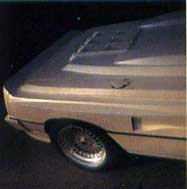
The main roof section of the hood itself is a combination of aluminium and GRP, covered with double duck weatherproofing material and fully trimmed to match the Esprit's stylish interior. We were a little disappointed to find plastic being used for the shallow rear window section, but impressed with the ease by which the assembly can be stowed in the shallow area behind the 1973cc carburettored four-cylinder engine.
Most contentious amongst the modifications must be the extensions to the Esprit's front and rear wings. For while Paul Bailey's faithful use of identical radii in the additional curves must be commended, opinions are divided on the need for such alteration to Giorgetto Giugiaro's 1972 design. 'It was important to stay with the angularity of the original theme,' Paul explains. 'while at the same time recognising how the styling of cars has changed over the last 15 to 20 years In any case, the wheelarch extensions are options _ as is the Turbo-style rear spoiler.'
Public reaction to the PBB conversion, henceforth christened the 'St Tropez' Spyder, has been very favourable, with interest expressed at our Supercar Test Day and a small number of Club Lotus meetings having prompted Paul to look very closely at the commercial prospects for the modifications. The market research is paying rich dividends. Customers are already seizing upon the prospect of converting any Series 1, 2 or 3 Esprits to soft-top form with Paul Bailey having a stream of calls to his 04545 3103 telephone number. With all structural work completed in four to five weeks, the new panels colour matched to those of the original vehicle, the conversion looks to be good value at around £3,000.
Wheelarch extensions can also be carried out by PBB Design, while other Esprit owners will doubtless leap at the opportunity to add rear spoilers and rear valance panels in the style of the more prestigious Turbo models.
Having won critical acclaim for this Spyder conversion, then, how does Paul view the future for his young company? 'It's important that we take things step by step,' he says. 'Having first moved to premises where this work can be done to the necessary high standards, we will be going on to offer similar conversions for the new generation Peter Stevens designed Esprit as well.'
Completed design work for conversions to the current model suggest that it would be a little less flamboyant , but certainly no less desirable than the modified Giugiaro supercar. Greater use of curves is clear, but most notable is the use of the sill air intake form for additional air intake in the upper section. A neat finishing touch to a thoroughly professional piece of design work – and with even clearer potential.
After that? Paul grins. 'Well, it may be a few years down the road yet, but I would eventually like to see my Jaguar XJ-S conversion on the road too. And it may not be such a distant vision, after all. You'll just have to wait and see...'
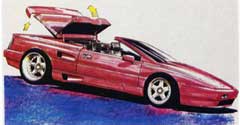
Stevens Lotus Convertible
As can be seen above the PBB 'St Tropez' conversion on the Lotus Esprit S3 and Turbo models works, and exceptionally well at that. In the project's four year gestation period, however, Peter Stevens at Lotus rather spoilt the impact of the PBB car by revising the Esprit body shape and thereby relegating the conversion to the secondhand market.
To combat that, Paul Bailey has been busy with the newer Lotus – which is virtually the same under the new skin – and has taken the opportunity to introduce some additional refinements in the way of a two-piece hood and engine cover along with wheelarch flares and an additional duct for cooling. Typical of the attention to detail evident in all PBB projects is the cooling orifice which mirrors, in inverted fashion, the one already present fore of the rear wheelarch on the standard car.
So for Lotus owners who wish to go al fresco, here is a well engineered conversion that simply must be worthy of more than a passing glance such is its integrity. The choice is yours...
|
|